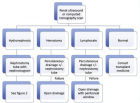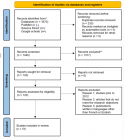Abstract
Review Article
Cyberbullying: A narrative review
Tiffany Field*
Published: 21 August, 2018 | Volume 2 - Issue 2 | Pages: 010-027
A literature search was conducted using PubMed and PsycINFO to locate cyberbullying research that was published during the last 4 years. In this narrative review, cyberbullying research is briefly summarized and critiqued. The review is focused on the varying definitions and characteristics of cyberbullies, victims and bystanders. Highly variable prevalence rates have been reported for cyberbullies, victims and bystanders as a function of age, gender, country, size of the social network and socioeconomic factors. In addition, the effects of cyberbullying are reviewed including the frequent suicide attempts along with risk factors/predictors of cyberbullying which include previous cyberbullying, excessive internet use and lack of empathy, anger, narcissism and authoritarian/permissive parenting. To reflect the recent literature, special attention is given to the studies on victims of bullying. Research on cyberbullies and on prevention/intervention programs for bullying is extremely limited despite the increasing prevalence of bullying and the rapidly accumulating literature. Methodological limitations include the primary focus on the prevalence of bullying and on the victims of bullying. Longitudinal, multivariate studies are needed to identify profiles on risk factors for bullying that can inform prevention programs.
Read Full Article HTML DOI: 10.29328/journal.jatr.1001007 Cite this Article Read Full Article PDF
References
- Vismara MFM, Toaff J, Pulvirenti G, Settanni C, Colao E, et al. Internet use and access, behavior, cyberbullying, and grooming: Results of an investigative whole city survey of adolescents. Interact J Med Res. 2017; 6: e9. Ref.: https://tinyurl.com/y72wztjw
- Garett R, Lord LR, Young SD. Associations between social media and cyberbullying: A review of the literature. M health. 2016; 2: 46. Ref.: https://tinyurl.com/y9mpvn4p
- Huang YY, Chang CM, Chen Y, Wei HC, Chou C. An analysis of adverse beliefs about cyberbullying among Taiwanese adolescents. Violence Vict. 2016; 31: 1116-1134. Ref.: https://tinyurl.com/ybgdnnun
- Cuadrado I, Fernandez I. Adolescents’ perception of the characterizing dimensions of cyberbullying differentiation between bullies’ and victims’ perceptions. Computers and Human Development. 2016; 55: 653-663. Ref.: https://tinyurl.com/yc5vazp6
- Remond JJ, Kern L, Romo L. A cyberbullying study: Analysis of cyberbullying, comorbidities and coping mechanisms. Encephale. 2015; 41: 287-294. Ref.: https://tinyurl.com/yanzfqxf
- Berne S, Frisen A, Kling J. Appearance-related cyberbullying: A qualitative investigation of characteristics, content, reasons, and effects. Body Image. 2014; 11: 527-533. Ref.: https://tinyurl.com/y9zob4va
- Wolke D, Lee K, Guy A. Cyberbullying: A storm in a teacup? Eur Child Adolesc Psychiatry. 2017; 26: 899-908. Ref.: https://tinyurl.com/ydxtsbce
- Schneider SK, O’Donnell L, Stueve A, Coulter RWS. Cyberbullying, school bullying, and psychological distress:A regional census of high school students. Am J Public Health. 2012; 102: 171-177. Ref.: https://tinyurl.com/yc7jjcgm
- Van Geel M, Vedder P, Tanilon J. Relationship between peer victimization, cyberbullying, and suicide in children and adolescents: A meta-analysis. JAMA Pediatr. 2014; 168: 435-442. Ref.: https://tinyurl.com/ycwngu7j
- Vaillancourt T, Faris R, Mishna F. Cyberbullying in children and youth: Implications for Health and clinical practice. Can J Psychiatry. 2017; 62: 368-373. Ref.: https://tinyurl.com/y8gszpxc
- Garaigordobil M. Psychometric properties of the cyberbullying test, a screening instrument to measure cybervictimization, cyberaggression, and cyberobservation. J Interpers Violence. 2015.
- Bottino SM, Bottino CM, Regina CG, Correia AV, Ribeiro WS. Cyberbullying and adolescent mental health: Systematic review. Cadernos de saúde pública. 2015; 31: 463-475. Ref.: https://tinyurl.com/y7sr8jnr
- Brochado S, Soares S, Fraga S. A scoping review on studies of cyberbullying prevalence among adolescents. Trauma Violence Abuse. 2017; 18: 523-531. Ref.: https://tinyurl.com/ycvnjxvn
- Bevilacqua L, Shackleton N, Hale D, Allen E, Bond L, et al. The role and school-level factors in bullying and cyberbullying: A cross-sectional study. BMC Pediatrics. 2017; 17: 160. Ref.: https://tinyurl.com/y9eruxm5
- Rice E, Petering R, Rhoades H, Winetrobe H, Goldbach J, et al. Cyberbullynig perpetration and victimization among middle-school students. Am J Public Health. 2015; 105: 66-72. Ref.: https://tinyurl.com/ybvrp4re
- Sharma D, Kishore J, Sharma N, Duggal M. Aggression in schools: Cyberbullying and gender issues. Asian J Psychiatr. 2017; 29: 142-145. Ref.: https://tinyurl.com/y8al9sfg
- Kessel Schneider SK, O’Donnell L, Smith E. Trends in cyberbullying and school bullying victimization in a regional census of high school students 2006-2012. The Journal of School Health. 2015; 85: 611-620. Ref.: https://tinyurl.com/y7287jam
- Rao J, Wang H, Pang M, Yang J, Zhang J, et al. Cyberbullying perpetration and victimization among junior and senior high school students in Guangzhou, China. Injury Prevention, 2017.
- Gkiomisi A, Gkrizioti M, Gkiomisi A, Anastasilakis DA, Kardaras P. Cyberbullying among Greek high school adolescents. Indian J Pediatr. 2017; 84: 364-368. Ref.: https://tinyurl.com/ybm93hpk
- Hemphill SA, Heerde JA. Adolescent predictors of young adult cyberbullying perpetration and victimization among Australian youth. J Adolesc Health. 2014; 55: 580-587. Ref.: https://tinyurl.com/ycte9ao9
- Cunningham CE, Chen Y, Vaillancourt T, Rimas H, Deal K, et al. Modeling the anti-cyberbullying preferences of university students: Adaptive choice-based conjoint analysis. Aggress Behav. 2015; 41: 369-385. Ref.: https://tinyurl.com/yaq7af34
- Selkie EM, Kota R, Moreno M. Cyberbullying among female college students: Witnessing, perpetration, and victimization. Coll Stud J. 2016; 50: 278-287. Ref.: https://tinyurl.com/yam2ne5v
- Lee JY, Kwon Y, Yang S, Park S, Kim EM, et al. Differences in friendship networks and experiences of cyberbullying among Korean and Australian adolescents. Journal of Genetic Psychology. 2017; 178: 44-57. Ref.: https://tinyurl.com/y9yp5szl
- Soares S, Brochado S, Barros H, Fraga S. Does cyberbullying prevalence among adolescents relate with country socioeconomic and development indicators? An Ecological study of 31 Countries. Violence Vict. 2017; 32: 771-790. Ref.: https://tinyurl.com/y8kgq2zh
- Messias E, Kindrick K, Castro J. School bullying, cyberbullying, or both: Correlates of teen suicidality in the 2011 CDC youth risk behavior survey. Compr Psychiatry. 2014; 55: 1063-1068. Ref.: https://tinyurl.com/y7azefcv
- John A, Glendenning AC, Marchant A, Montgomery P, Stewart A, et al. Self-harm, suicidal behaviors, and cyberbullying in children and young people: Systematic review. J Med Internet Res. 2018; 20: e129. Ref.: https://tinyurl.com/y7a4vgfo
- Extremera N, Quintana-Ortis C, Merida-Lopez S, Rey L. Cyberbullying victimization, self-esteem and ideation in adolescence: Does emotional intelligence play a buffering role? Front Psychol. 2018; 9: 367. Ref.: https://tinyurl.com/y8ow7hor
- Young R, Subramanian R, Miles S, Hinnant A, Andsager JL. Social representation of cyberbullying and adolescent suicide: A mixed-method analysis of news stories. Health Commun. 2017; 32: 1082-1092. Ref.: https://tinyurl.com/ybowofna
- Tural Hesapcioglu S, Ercan F. Traditional and cyberbullying co-occurrence and its relationship to psychiatric symptoms. Pediatr Int. 2017; 59: 16-22. Ref.: https://tinyurl.com/ycxdcdur
- Fahy AE, Stanfeld SA, Smuk M, Smith NR, Cummins S, et al. Longitudinal associations between cyberbullying involvement and adolescent mental health. J Adolesc Health. 2016; 59: 502-509. Ref.: https://tinyurl.com/ybjenjky
- Hamm MP, Newton AS, Chisholm A, Shulhan J, Milne A, et al. Prevalence and effect of cyberbullying on children and young people: A scoping view of social media studies. JAMA Pediatr. 2015; 169: 770-777. Ref.: https://tinyurl.com/y8ddlawa
- Waasdorp TE, Bradshaw CP. The overlap between cyberbullying and traditional bullying. J Adolesc Health. 2015; 56: 483-488. Ref.: https://tinyurl.com/y7v5ea26
- Nixon CL. Current perspectives: The impact of cyberbullying on adolescent health. Adolesc Health Med Ther. 2014; 5: 143-158. Ref.: https://tinyurl.com/y72kwrtm
- Kim S, Colwell SR, Kata A, Boyle MH, Georgiades K. Cyberbullying victimization and adolescent mental health: Evidence of differential effects by sex and mental health problem type. J Youth Adolesc. 2018; 47: 661-672. Ref.: https://tinyurl.com/ya4aqpwx
- Cassidy W, Faucher C, Jackson M. Adversity in University: Cyberbullying and its impacts on students, faculty and administrators. Int J Environ Res Public Health. 2017; 14: 888. Ref.: https://tinyurl.com/yczvaux6
- Aboujaoude E, Savage MW, Starcevic V, Salame WO. Cyberbullying: Review of an old problem gone viral. J Adolesc Health. 2015; 57: 10-18. Ref.: https://tinyurl.com/y99yz7eh
- Sampasa-Kanyinga H, Hamilton HA. Use of social networking sites and risk of cyberbullying victimization: A population-level study of adolescents. Cyberpsychol Behav Soc Netw. 2015; 18: 704-710. Ref.: https://tinyurl.com/yc4g2wmj
- Kenny U, Sullivan L, Callaghan M, Molcho M, Kelly C. The relationship between cyberbullying and friendship dynamic on adolescent body dissatisfaction: A cross-sectional study. J Health Psychol. 2018; 23: 629-639. Ref.: https://tinyurl.com/ya82cedg
- Olenik-Shemesh D, Heiman T, Eden S. Bystanders’ behavior in cyberbullying episodes: Active and passive patterns in the context of personal-socio-emotional factors. J Interpers Violence. 2017; 32: 23-48. Ref.: https://tinyurl.com/yd9ehsqx
- Ramos Salazar L. Cyberbullying victimization as a predictor of cyberbullying perpetration, body image dissatisfaction, healthy eating and dieting behaviors, and life satisfaction. J Interpers Violence. 2017. Ref.: https://tinyurl.com/ybr3qcsw
- Alonzo C, Romero E. Aggressors and victims in bullying and cyberbullying: A study of personality profiles using the Five-Factor model. Span J Psychol. 2017; 20: E76. Ref.: https://tinyurl.com/yb3wokmr
- Laftman SB, Alm S, Sandahl J, Modin B. Future orientation among students exposed to school bullying and cyberbullying victimization. Int J Environ Res Public Health. 2018; 15: E605. Ref.: https://tinyurl.com/y8wwjbod
- Zsila A, Orosz G, Kiraly O, Urban R, Ujhelyi A, et al. Psychoactive substance use and problematic internet use as predictors of bullying and cyberbullying victimization. Int J Ment Health Addict. 2018; 16: 466-479. Ref.: https://tinyurl.com/ybgamt2h
- Kim S, Boyle MH, Georgiades K. Cyberbullying victimization and its association with health across the life course: A Canadian population study. Can J Public Health. 2018; 108: e468-e474. Ref.: https://tinyurl.com/y93zq3np
- Spears BA, Taddeo CM, Daly AL, Stretton A, Karklins LT. Cyberbullying, help-seeking and mental health in young Australians: Implications for public health. Int J Public Health. 2015; 60: 219-226. Ref.: https://tinyurl.com/ycb7odrd
- Sampasa-Kanyinga H. Co-occurring cyberbullying and school bullying victimization and associations with mental health problems among Canadian middle and high school students. Violence Vict. 2017; 32: 671-687. Ref.: https://tinyurl.com/yauegodw
- Nikolaou D. Does cyber bullying impact youth suicidal behaviors? J Health Econ. 2017; 56: 30-46. Ref.: https://tinyurl.com/yd35fnd3
- Kowalski RM, Giumetti GW, Schroeder AN, Lattanner MR. Bullying in the digital age: A critical review and meta-analysis of cyberbullying research among youth. Psychological Bulletin. 2014; 140: 1073-1137. Ref.: https://tinyurl.com/yc54jcnx
- Ranney ML, Patena JV, Nugent N, Spirito A, Boyer E, et al. PTSD, cyberbullying and peer violence: Prevalence and correlates among adolescent emergency department patients. Gen Hosp Psychiatry. 2016; 39: 32-38. Ref.: https://tinyurl.com/y82y9ogf
- Chen Q Lo, CKM, Zhu Y, Cheung A, Chan KL, et al. Family poly-victimization and cyberbullying among adolescents in a Chinese school sample. Child Abuse Negl. 2018; 77: 180-187. Ref.: https://tinyurl.com/y8y7pd3z
- Olenik-Shemesh D, Heiman T. Cyberbullying victimization in adolescents as related to body esteem, social support, and social self-efficacy. Journal of Genetic Psychology. 2017; 178: 28-43. Ref.: https://tinyurl.com/yda3jgjr
- Van Cleemput K, Vanderbosch H, Pabian S. Personal characteristics and contextual factors that determine “helping,” “joining in,” and “doing nothing” when witnessing cyberbullying. Aggress Behav. 2014; 40: 383-396. Ref.: https://tinyurl.com/y8bd6sjm
- Machackova H, Dedkova L, Mezulanikova K. Brief report: The bystander effect in cyberbullying incidents. J Adolesc. 2015; 43: 96-99. Ref.: https://tinyurl.com/yd9jq3t8
- Holfeld B, Mishna F. Longitudinal associations in youth involvement as victimized, bullying, or witnessing cyberbullying. Cyberpsychol Behav Soc Netw. 2018; 21: 234-239. Ref.: https://tinyurl.com/ybdnahp8
- Barlinska J, Szuster A, Winiewski M. The role of short- and long-term cognitive empathy activation in preventing cyberbystander reinforcing cyberbullying behavior. Cyberpsychol Behav Soc Netw. 2015; 18: 241-244. Ref.: https://tinyurl.com/ybuwd5fy
- Chaux E, Velasquez AM, Schultze-Krumbholz A, Scheithauer H. Effects of the cyberbullying prevention program media heroes (Medienhelden) on traditional bullying. Aggress Behav. 2016; 42: 157-165. Ref.: https://tinyurl.com/y7e4odmn
- Garcia Fernandez CM, Romera Felix EM, Ortega Ruiz R. Explicative factors of face-to-face harassment and cyberbullying in a sample of primary students. Psicothema. 2015; 27: 347-353. Ref.: https://tinyurl.com/y84k9ga8
- Llorent VJ, Ortega-Ruiz R, Zych I. Bullying and cyberbullying in the minorities: Are they more vulnerable than the majority group? Front Psychol. 2016; 7: 1507. Ref.: https://tinyurl.com/y789wzu3
- Barlett CP. Predicting adolescent’s cyberbullying behavior: A longitudinal risk analysis. J Adolesc. 2015; 41: 86-95. Ref.: https://tinyurl.com/y8y2r7dh
- Hebert M, Cenat JM, Blais M, Lavoie F, Guerrier M. Child sexual abuse, bullying, cyberbullying, and metal health problems among high school students: A moderated mediated model. Canadian Institutes of Health Research. 2016; 33: 623-629. Ref.: https://tinyurl.com/ycg9z3hx
- Chao CM, Yu TK. Associations among different internet access time, gender and cyberbullying behaviors in Taiwan’s adolescents. Front Psychol. 2017; 8: 1104. Ref.: https://tinyurl.com/yd8x3amj
- Gamez-Guadix M, Borrajo E, Almendros C. Risky online behaviors among adolescents: Longitudinal relations among problematic internet use, cyberbullying perpetration and meeting strangers online. J Behav Addict. 2016; 5: 100-107. Ref.: https://tinyurl.com/ycx6fvte
- Tsimtsiou Z, Haidich AB, Drontsos A, Dantsi F, Sekeri Z, et al. Pathological internet use, cyberbullying and mobile phone use in adolescence: A school-based study in Greece. International Journal of Adolescent Medicine and Health. 2017. Ref.: https://tinyurl.com/yary826l
- Festi R, Quandt T. The role of online communication in long-term cyberbullying involvement among girls and boys. J Youth Adolesc. 2016; 45: 1931-1945. Ref.: https://tinyurl.com/yblbxatp
- Den Hamer AH, Konijn EA. Adolescents’ media exposure may increase their cyberbullying behavior: A longitudinal study. J Adolesc Health. 2015; 56: 203-208. Ref.: https://tinyurl.com/ybqjorp7
- Chang FC, Chiu CH, Miao NF, Chen PH, Lee CM, et al. Online gaming and risks predict cyberbullying perpetration and victimization in adolescents. Int J Public Health. 2015; 60: 257-266. Ref.: https://tinyurl.com/y968xjfz
- Erreygers S, Vandebosch H, Vranjes I, Baillien E, De Witte H. The longitudinal association between poor sleep quality and cyberbullying, mediated by anger. Health Commun. 2018; 9: 1-7. Ref.: https://tinyurl.com/ycb8joyx
- Lonigro A, Schneider BH, Laghi F, Baiocco R, Pallini S, et al. Is cyberbullying related to trait or state anger? Child Psychiatry Hum Dev. 2015; 46: 445-454. Ref.: https://tinyurl.com/y8h88ppg
- Fletcher A, Fitzgerald-Yau N, Jones R, Allen E, Viner RM, et al. Brief report: Cyberbullying perpetration and its associations with socio-demographics, aggressive behavior at school, and mental health outcomes. J Adolesc. 2014; 37: 1393-1398. Ref.: https://tinyurl.com/yaefgmeg
- Pabian S, Vandebosch H. An investigation of short-term longitudinal associations between social anxiety and victimization and perpetration of traditional bullying and cyberbullying. J Youth Adolesc. 2016; 45: 328-339. Ref.: https://tinyurl.com/y8xg6rhy
- Palladino BE, Menesini E, Nocentini A, Luik P, Naruskov K, et al. Perceived severity of cyberbulling: Differences and similarities between four countries. Front Psychol. 2017; 8: 1524. Ref.: https://tinyurl.com/y7lewhqm
- Machackova H, Pfetsch J. Bystanders’ responses to offline bullying and cyberbullying: The role of empathy and normative beliefs about aggression. Scand J Psychol. 2016; 57: 169-176. Ref.: https://tinyurl.com/ybg5a3uw
- Ciucci E, Baroncelli A. Emotion-related personality traits and peer social standing: Unique and interactive effects in cyberbullying behaviors. Cyberpsychol Behav Soc Netw. 2014; 17: 584-590. Ref.: https://tinyurl.com/y7br3wz9
- Orue I, Calvete E. Psychopathic traits and moral disengagement interact to predict Bullying and cyberbullying among adolescents. J Interpers Violence. 2016. Ref.: https://tinyurl.com/ydfwa9uu
- Fan CY, Chu XW, Zhang M, Zhou ZK. Are narcissists more likely to be involved in cyberbullying? Examining the mediating role of self-esteem. J Interpers Violence. 2016. Ref.: https://tinyurl.com/ydhlf9ze
- Garaigordobil M, Machimbarrena JM. Stress, competence, and parental educational styles in victims and aggressors of bullying and cyberbullying. Psicothema. 2017; 29: 335-340. Ref.: https://tinyurl.com/y73hbmuh
- Hinduja S, Patchin JW. Cultivating youth resilience to prevent bullying and cyberbullying victimization. Child Abuse Negl. 2017; 73: 51-62. Ref.: https://tinyurl.com/yck5n3tf
- Jacobs NC, Dehue F, Vollink T, Lechner L. Determinants of adolescents’ ineffective and improved coping with cyberbullying: A Delpi study. J Adolesc. 2014; 37: 373-385. Ref.: https://tinyurl.com/ycsbcf6n
- Orel A, Campbell M, Wozencroft K, Leong E, Kimpton M. Exploring university students’ coping strategy intentions for cyberbullying. J Interpers Violence. 2015. Ref.: https://tinyurl.com/y7dev6s8
- Na H, Dancy BL, Park C. College student engaging in cyberbullying victimization: Cognitive appraisals, coping strategies, and psychological adjustments. Arch Psychiatr Nurs. 2015; 29: 155-161. Ref.: https://tinyurl.com/ydxgqz8q
- Khoury-Kassabri M, Mishna F, Massarwi AA. Cyberbullying perpetration by Arab youth: The direct and interactive role of individual, family, and neighborhood characteristics. J Interpers Violence. 2016. Ref.: https://tinyurl.com/yamfpa3m
- Chang FC, Chiu CH, Miao NF, Chen PH, Lee CM, et al. The relationship between parental mediation and internet addiction among adolescents, and the association with cyberbullying and depression. Compr Psychiatry. 2015; 57: 21-28. Ref.: https://tinyurl.com/y9togm52
- Chng GS, Liau A, Khoo A, Li D. Parental mediation and cyberbullying: A longitudinal study. Stud Health Technol Inform. 2014; 199: 98-102. Ref.: https://tinyurl.com/yc6ogzeh
- Elgar FJ, Napoletano A, Saul G, Dirks MA, Craig W, et al. Cyberbullying victimization and mental health in adolescents and the moderating role of family dinners. JAMA Pediatr. 2014; 168: 1015-1022. Ref.: https://tinyurl.com/y8huy9mk
- Doane AN, Kelley Ml, Pearson MR. Reducing cyberbullying: A theory of reasoned action-based video prevention program for college students. Aggress Behav. 2016; 42: 136-146. Ref.: https://tinyurl.com/y74kat32
- Schultze-Krumbholz A, Schultze M, Zaggorscak P, Wolfer R, Scheithauer H. Feeling cybervictims’ pain: The effect of empathy training on cyberbullying. Aggress Behav. 2016; 42: 147-156. Ref.: https://tinyurl.com/yalsccny
- Barkoukis V, Lazuras L, Ourda D, Tsorbatzoudis H. Tackling psychosocial risk factors for adolescent cyberbullying: Evidence from a school-based intervention. Aggress Behav. 2016; 42: 114-122. Ref.: https://tinyurl.com/ya39dkb9
- Cross D, Shaw T, Hadwen K, Cardoso P, Slee P, et al. Longitudinal impact of the cyber friendly schools program on adolescents’ cyberbullying behavior. Aggress Behav. 2016; 42: 166-180. Ref.: https://tinyurl.com/ybxmr7v9
- Parris LN, Varjas K, Meyers J. “The internet is a mask”: High school students’ suggestions for preventing cyberbullying. West J Emerg Med. 2014; 15: 587-592. Ref.: https://tinyurl.com/y7dnjzk7
- Palladino BE, Nocentini A, Menesini E. Evidence-based intervention against bullying and cyberbullying: Evaluation of the NoTrap! Program in two independent trials. Aggress Behav. 2016; 42: 194-206. Ref.: https://tinyurl.com/ydy655lo
- Hutson E, Kelly S, Militello LK. Systematic review of cyberbullying interventions for youth and parents with implications for evidence-based practice. Worldviews Evid Based Nurs. 2018; 15: 72-79. Ref.: https://tinyurl.com/ybzltggs
- Runions KC, Bak M. Online moral disengagement, cyberbullying, and cyber-aggression. Cyberpsychology Behavior and Social Networking. 2015; 18: 400-405. Ref.: https://tinyurl.com/y9vuc8qn
- Mitchell SM, Seegan PL, Roush JF, Brown SL, Susaita MA, et al. Retrospective cyberbullying and suicide ideation: The Medaiting roles of depressive symptoms, perceived burdensomeness, and thwarted belongingness. J Interpers Violence. 2016; 33: 2602-2620. Ref.: https://tinyurl.com/ybrcql73
- Wachs S, Bilz L, Fischer SM, Wright MF. Do emotional components of alexithymia mediate the interplay between cyberbullying victimization and perpetration? Int J Environ Res Public Health. 2017; 14: E1530. Ref.: https://tinyurl.com/ybe8byeg
- Elipe P, Mora-Merchan JA, Naciemento L. Development and validation of an instrument to assess the impact of cyberbullying: The cybervictimization emotional impact scale. Cyberpsychol Behav Soc Netw. 2017; 20: 479-485. Ref.: https://tinyurl.com/y7mnkkxf
- Dredge R, Gleeson J, Garcia Xde L. The development and validation of the social networking expriences questionnaire: A measure of adolescent cyberbullying and its impact. Violence and Victims, 2015; 30: 798-812.
- Betts LR, Spenser KA. Deveoping the cyber victimization experiences and cyberbullying behaviors scales. J Genet Psychol. 2017; 178: 147-164. Ref.: https://tinyurl.com/y7gkbuh6
- Olweus D, Limber SP. Some problems with cyberbullying research. Current Opinion in Psychology. 2018; 19: 139-143. Ref.: https://tinyurl.com/yazo2yqq
- Ciucci E, Baroncelli A, Nowicki S. Emotion perception accuracy and bias in face-to-face versus cyberbullying. J Genet Psychol. 2014; 175: 382-400. Ref.: https://tinyurl.com/y9lhj8cl
- Pfetsch JS. Empathic skills and cyberbullying: Relationship of different measures of empathy to cyberbullying in comparison to offline bullying among young adults. J Genet Psychol. 2017; 178: 58-72. Ref.: https://tinyurl.com/y8efmh2t
Similar Articles
-
Novel Challenges for the Therapeutics of Depression: Pharmacological Modulation of Interaction between the Intracellular Signaling Pathways Mediated by Ca2+ and cAMPAfonso Caricati-Neto,Leandro Bueno Bergantin*. Novel Challenges for the Therapeutics of Depression: Pharmacological Modulation of Interaction between the Intracellular Signaling Pathways Mediated by Ca2+ and cAMP . . 2017 doi: 10.29328/journal.jatr.1001001; 1: 001-006
-
Predictive Psychological Factors of Problematic Alcohol use in University StudentsHatice Demirbas*. Predictive Psychological Factors of Problematic Alcohol use in University Students . . 2017 doi: 10.29328/journal.jatr.1001002; 1: 007-015
-
Addiction to self-strangulation: a case-reportAurely Ameller*,Yann Le Strat,Marion Cadranel,Celine Portalier, Caroline Dubertret. Addiction to self-strangulation: a case-report . . 2017 doi: 10.29328/journal.jatr.1001003; 1: 016-021
-
The effects of alcohol taxation and pricing policies on vodka sales in RussiaRazvodovsky YE*. The effects of alcohol taxation and pricing policies on vodka sales in Russia . . 2017 doi: 10.29328/journal.jatr.1001004; 1: 022-025
-
Alcohol-related poisonings in Russia: Obfuscated factsSergei V Jargin*. Alcohol-related poisonings in Russia: Obfuscated facts. . 2018 doi: 10.29328/journal.jatr.1001005; 2: 001-005
-
Parental Role in Adolescent Substance Abuse PreventionShelby Miller*. Parental Role in Adolescent Substance Abuse Prevention . . 2018 doi: 10.29328/journal.jatr.1001006; 2: 006-009
-
Cyberbullying: A narrative reviewTiffany Field*. Cyberbullying: A narrative review. . 2018 doi: 10.29328/journal.jatr.1001007; 2: 010-027
-
Factors affecting physical activity of recuperating alcoholics in Asumbi-Homabay rehabiliation center, KenyaLucy Amanya Mutuli*,Peter Bukhala and Gordon Nguka,Gordon Nguka. Factors affecting physical activity of recuperating alcoholics in Asumbi-Homabay rehabiliation center, Kenya . . 2018 doi: 10.29328/journal.jatr.1001008; 2: 028-034
-
A forensic treatment-monitoring study of an adult with attention-deficit disorder with hyperactivity and substance use disorderNiels Peter Nielsen,Elisabeth H Wiig*. A forensic treatment-monitoring study of an adult with attention-deficit disorder with hyperactivity and substance use disorder. . 2019 doi: 10.29328/journal.jatr.1001009; 3: 001-008
-
Assessment of physicians’ knowledge, attitudes, and practices regarding smoking cessation management in the Gaza StripKhaled Hani Alkhodari,Bakr Khadr Abo Jarad,Ahmed Ismail Al-Bahbhani,Sadi Yehia Nkhala,Ali Naim Al-Buhisi, Khamis Abdelkarim Elessi. Assessment of physicians’ knowledge, attitudes, and practices regarding smoking cessation management in the Gaza Strip. . 2020 doi: 10.29328/journal.jatr.1001010; 4: 001-005
Recently Viewed
-
Late discover of a traumatic cardiac injury: Case reportBenlafqih C,Bouhdadi H*,Bakkali A,Rhissassi J,Sayah R,Laaroussi M. Late discover of a traumatic cardiac injury: Case report. J Cardiol Cardiovasc Med. 2019: doi: 10.29328/journal.jccm.1001048; 4: 100-102
-
A two-phase sonographic study among women with infertility who first had normal sonographic findingsKalu Ochie*,Abraham John C. A two-phase sonographic study among women with infertility who first had normal sonographic findings. Clin J Obstet Gynecol. 2022: doi: 10.29328/journal.cjog.1001117; 5: 101-103
-
Sinonasal Myxoma Extending into the Orbit in a 4-Year Old: A Case PresentationJulian A Purrinos*, Ramzi Younis. Sinonasal Myxoma Extending into the Orbit in a 4-Year Old: A Case Presentation. Arch Case Rep. 2024: doi: 10.29328/journal.acr.1001099; 8: 075-077
-
Analysis of Psychological and Physiological Responses to Snoezelen Multisensory StimulationLucia Ludvigh Cintulova,Jerzy Rottermund,Zuzana Budayova. Analysis of Psychological and Physiological Responses to Snoezelen Multisensory Stimulation. J Neurosci Neurol Disord. 2024: doi: 10.29328/journal.jnnd.1001103; 8: 115-125
-
Feature Processing Methods: Recent Advances and Future TrendsShiying Bai,Lufeng Bai*. Feature Processing Methods: Recent Advances and Future Trends. J Clin Med Exp Images. 2025: doi: 10.29328/journal.jcmei.1001035; 9: 010-014
Most Viewed
-
Evaluation of Biostimulants Based on Recovered Protein Hydrolysates from Animal By-products as Plant Growth EnhancersH Pérez-Aguilar*, M Lacruz-Asaro, F Arán-Ais. Evaluation of Biostimulants Based on Recovered Protein Hydrolysates from Animal By-products as Plant Growth Enhancers. J Plant Sci Phytopathol. 2023 doi: 10.29328/journal.jpsp.1001104; 7: 042-047
-
Sinonasal Myxoma Extending into the Orbit in a 4-Year Old: A Case PresentationJulian A Purrinos*, Ramzi Younis. Sinonasal Myxoma Extending into the Orbit in a 4-Year Old: A Case Presentation. Arch Case Rep. 2024 doi: 10.29328/journal.acr.1001099; 8: 075-077
-
Feasibility study of magnetic sensing for detecting single-neuron action potentialsDenis Tonini,Kai Wu,Renata Saha,Jian-Ping Wang*. Feasibility study of magnetic sensing for detecting single-neuron action potentials. Ann Biomed Sci Eng. 2022 doi: 10.29328/journal.abse.1001018; 6: 019-029
-
Pediatric Dysgerminoma: Unveiling a Rare Ovarian TumorFaten Limaiem*, Khalil Saffar, Ahmed Halouani. Pediatric Dysgerminoma: Unveiling a Rare Ovarian Tumor. Arch Case Rep. 2024 doi: 10.29328/journal.acr.1001087; 8: 010-013
-
Physical activity can change the physiological and psychological circumstances during COVID-19 pandemic: A narrative reviewKhashayar Maroufi*. Physical activity can change the physiological and psychological circumstances during COVID-19 pandemic: A narrative review. J Sports Med Ther. 2021 doi: 10.29328/journal.jsmt.1001051; 6: 001-007

HSPI: We're glad you're here. Please click "create a new Query" if you are a new visitor to our website and need further information from us.
If you are already a member of our network and need to keep track of any developments regarding a question you have already submitted, click "take me to my Query."


















































































































































